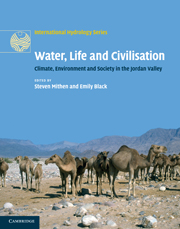Book contents
- Frontmatter
- Contents
- List of figures
- List of tables
- List of contributors
- Acknowledgements
- 1 Introduction: an interdisciplinary approach to Water, Life and Civilisation
- Part I Past, present and future climate
- 2 The present-day climate of the Middle East
- 3 Past climates of the Middle East
- 4 Future climate of the Middle East
- 5 Connecting climate and hydrological models for impacts studies
- Part II The palaeoenvironmental record
- Part III Hydrological studies of the Jordan Valley
- Part IV Human settlement, climate change, hydrology and water management
- Part V Palaeoeconomies and developing archaeological methodologies
- Part VI Society, economy and water today
- Part VII Conclusions
- Index
- Plate section
- References
2 - The present-day climate of the Middle East
from Part I - Past, present and future climate
Published online by Cambridge University Press: 26 April 2011
- Frontmatter
- Contents
- List of figures
- List of tables
- List of contributors
- Acknowledgements
- 1 Introduction: an interdisciplinary approach to Water, Life and Civilisation
- Part I Past, present and future climate
- 2 The present-day climate of the Middle East
- 3 Past climates of the Middle East
- 4 Future climate of the Middle East
- 5 Connecting climate and hydrological models for impacts studies
- Part II The palaeoenvironmental record
- Part III Hydrological studies of the Jordan Valley
- Part IV Human settlement, climate change, hydrology and water management
- Part V Palaeoeconomies and developing archaeological methodologies
- Part VI Society, economy and water today
- Part VII Conclusions
- Index
- Plate section
- References
Summary
ABSTRACT
The arid climate of the Middle East means that variations in rainfall on all timescales from days to years have an enormous impact on the people who live in the region. Understanding this variability is crucial if we are to interpret model simulations of the region's climate and make meaningful predictions of how the climate may change in the future and how it has changed in the past (Chapters 3 and 4). This study uses rain gauge measurements in conjunction with other meteorological data to address the following questions. How does rainfall vary from day to day and from year to year? How does rainfall vary spatially within Jordan and Israel? How does the atmospheric circulation over the Mediterranean region affect the daily probability of rain? What effect do large-scale modes of variability such as the North Atlantic Oscillation have on rainfall variability in the region?
INTRODUCTION
Variability in precipitation has posed a considerable challenge to the population of the Middle East throughout the Holocene, and continues to be a key issue today. Understanding this variability is crucial for the design and interpretation of climate model experiments that characterise how precipitation has changed in the past and predict how it will change in the future.
- Type
- Chapter
- Information
- Water, Life and CivilisationClimate, Environment and Society in the Jordan Valley, pp. 13 - 24Publisher: Cambridge University PressPrint publication year: 2011
References
- 1
- Cited by

